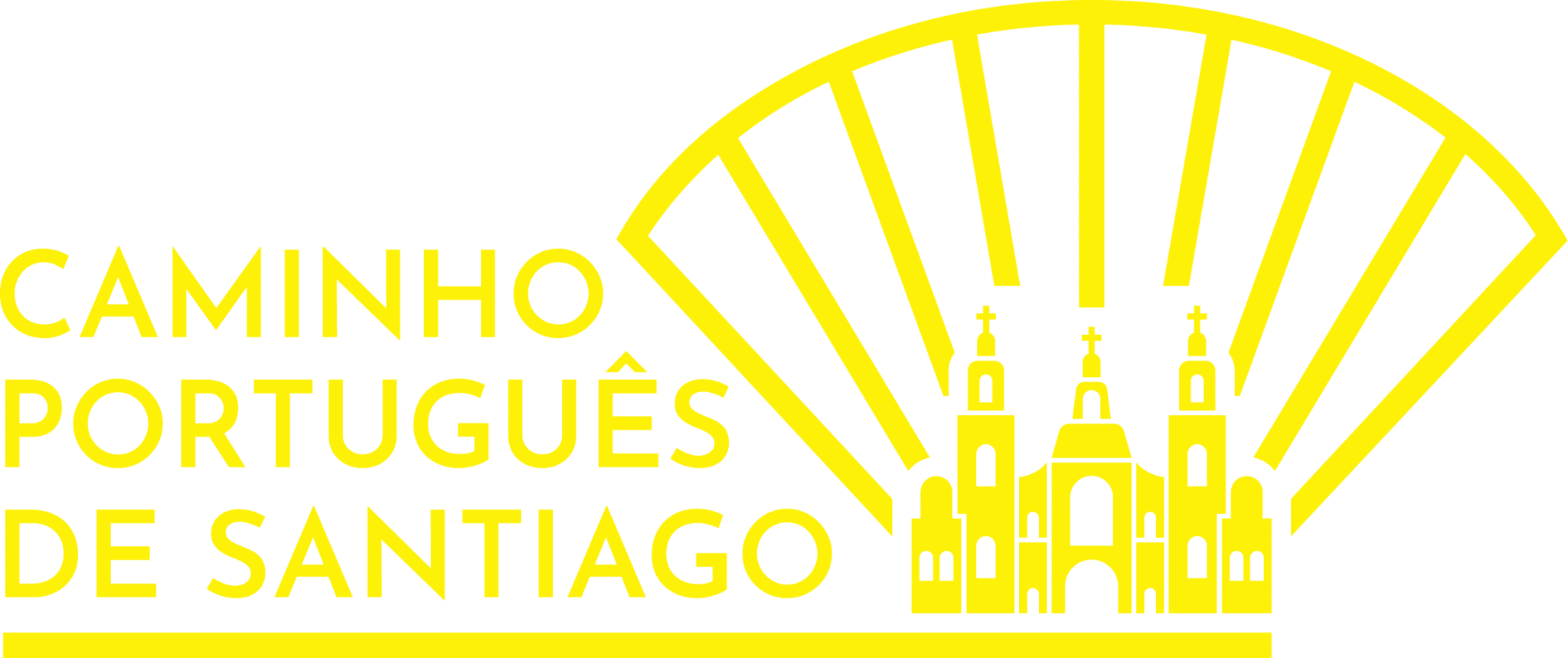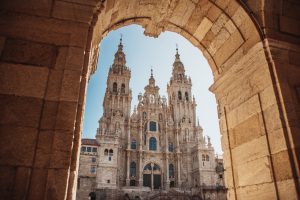There are no easy decisions on the millennial trail. The important thing is to have all the information you need to make the right choice when the time comes. So, between the coastal path and the central path, let the pilgrim come and choose. In this article, we've written about the strengths and weaknesses of each of the Portuguese Santiago routes. This will help you find out which roads suit you best. Shall we?
What's the difference between doing the Coastal Way and the Central Way?
A questão “Caminho Português da Costa ou Central?” tem muitas respostas. Isto porque ambos os trajetos têm as suas caraterísticas. O Caminho da Costa tem uma relação estreita com o oceano, estando ao seu lado em, praticamente, todo o trecho, enquanto o Central (e daí o nome) te leva pelo meio de Portugal e da Galiza. De maneira simplista, essa é a grande diferença entre estes dois caminhos portugueses.
But the truth is that the distinctions don't end there. Each town on the route has its own history with the road. What's more, the terrain covered by the walkers is so different that the experience in each place is unique. Even the cuisine, in towns less than 100 kilometers apart, changes completely. One wonders whether you prefer fish or meat, as the answer can help you choose!
Basically, both routes have their charms and dislikes. So let's get closer to the sea to find out if this is the Way for you!
Portuguese Camino de Santiago da Costa

- It's longer.
This Camino de Santiago is up to 280 kilometers long, especially if you choose the modern variation of the Senda Litoral. In other words, it's 20,000 meters longer than the central one. In other words, another stage. Despite this, the route to Santiago de Compostela has fewer mountains and climbs.
This way, even though you have to walk more, the effort may be less. At least here you don't have to climb the highest point of the Portuguese Camino de Santiago.
- You have more freedom to choose routes.
On this route, every day can be different, as we've seen before. Do you feel like sitting by the sea and watching the tide? You can follow the ocean. Fancy taking to the roads and mountains, getting to know the wildlife and people? Go ahead, you can too!
Planning is the key to understanding what you want to see, feel and experience at this very special moment in your life. To help you in this process, we have the steps described with the main points to visit, on our website, both for the Certified Coastal Pathas for the Senda Litoral.
- For those who like the sea, it's a treat.
It cannot be said enough. For those who love the ocean, there's no better route. From excellent restaurants with the freshest fish in the region, to the architecture of old fishing towns with their colorful stalls, everything seems to have been designed by Walt Disney himself.
However, as with everything in life, you have to be careful when everything seems wonderful. By going to the beach, the sun can cause increased dehydration and scalding. Even with the help of a hat, which you should always wear, the sand on the beach reflects 17% of UV radiation.
What's more, even though this part of the Iberian Peninsula has more clouds than the south, you still need to protect yourself from the biggest star in the Milky Way. This is because the rays can pass through this cloudy layer of sky, giving you a false sense of security along the way.
So don't forget your water and sunscreen - they'll be your best friends as you walk along the coastline of Portugal and Galicia.
- There are fewer people walking along the coast.
Depending on your perspective, it can be good or bad. As always, let's start by looking at the bright side of life to explain our point.
Along the way, you'll meet many other pilgrims. Coming from all over the world, this is an opportunity to come into contact with other cultures, languages and traditions that you would never expect to meet.
This way, with fewer people on the road, you have a better opportunity to build a relationship with these people, talk for longer and even create a circle of pilgrim friendships along the way.
This happens because the albergues have fewer people to accommodate. So, naturally, the people who accompany you on this adventure naturally move on to the same hostels, towns and restaurants that are less likely to be full.
However, since it's not so popular in the summer months, these social spaces easily fill up because there isn't enough infrastructure. This includes seating areas, cafés, water fountains and hostels.
All this, despite there being a local authorities' effortsThe road conditions in Portugal, which have improved in recent years, can make life difficult for pilgrims to Santiago. To prepare your Camino without thinking about these issues, take a look at our steps which have hostels, restaurants and places of interest designed for pilgrims!
The Central Portuguese Way
- In the absence of an ocean, we have unique rivers and the greenest mountains.
With several rivers along the way, at no time will you be accompanied by the Atlantic. However, it is advisable to bring your bathing suit and a towel. In Portugal alone, there are two wonderful river beaches in Barcelos and Ponte de Lima, ready to welcome fearless pilgrims. In fact, it's the perfect ingredient for the end of a long day. Especially if you arrive at what is one of the oldest villages in our country with time to rest, since it's a difficult and long stage.
- You won't get lost so easily.
The route has been well defined for millennia. That's why there's no room for improvisation on the Camino da Costa when you travel through central Portugal. It is therefore possible, but unlikely, to deviate from the established route. Even if you do, the locals will quickly warn you that you're heading in the wrong direction.
To find out more about the central stages, visit our dedicated tab, here.
- It is the second most visited by pilgrims.
The popularity of the central route is a source of pride for all of us. However, thanks to its history so closely linked to the construction of the country that is Portugal today, the economic importance of the crossings during the Middle Ages and policies to promote the route, it is only natural that this should be the case.
Thanks to the Black Death, the wars in Europe and the spread of Protestantism, the pilgrimage became a mirage of other times. In fact, there are reports from 1867 stating that only 40 pilgrims reached Santiago de Compostela that year.
However, much has changed over the years. With the promotion of the first Compostela Holy Year of the millennium in 2004 and the classification of the French Way as a World Heritage Site in 1993, Portugal and the Central Route have gained international relevance in this world. Combining good weather, low prices and incredible landscapes, this is the recipe for the success of this trail.
But every landscape has its drawbacks. More people means there's less space to take a quiet walk, with just you and your thoughts. What's more, despite the excellent infrastructure, in summer time it's always difficult to find somewhere to sleep, eat or simply rest.
- One step shorter.
For those with less time on their hands, the Central Way can be done in just 10 days. In fact, some people do it in just 5 or 6 days. You just have to go by bike, for example, or be in excellent physical shape.
But 10 days is the ideal time to get to know the best that the ancient trail has to offer. With the moments of rest, leisure and introspection that this requires. Make the most of it!
- You can find infrastructure easily.
Here, the law of supply and demand applies. Because there is so much demand, businesses and municipalities are better prepared to welcome pilgrims with quality. In other words, more places to rest, drink and eat.
However, if you prefer to do the Camino without so much comfort, this may not be the one for you. After all, it is one of the most popular routes. However, this "excessive tourism" tends to start in Valença or Tui, since it's from here that you have the minimum kilometers to reach Compostela.
Which do you prefer? The Portuguese Coastal Way or the Central Way?
In short, both paths have a unique beauty. Even with such a small country, there's enough geographical variety to have two such different trails. We're lucky to be so close to them, in Portugal.
Now you're missing. Have you done any of these routes? Are we missing any important distinctions? Talk to us in the comments!











Currently, in May 2023, the pressure on the Camino da Costa is much greater than on the Camino Central, and by then there are already several dozen (around a hundred) pilgrims. A lot of this exponential increase in pilgrims has to do with the fact that the exit from Porto to the Central Way is quite "ugly" and boring, at least on the way to Vilarinho (urban, industrial, highways, roads without sidewalks, etc).
So, as the goal is just one (Santiago de Compostela), why not take the first two stages of the coastal path to Póvoa de Varzim, taking advantage of the beauty of the route by the sea, and then from Póvoa de Varzim connect to the central path to Rates (12 km) using the footpath of the old railway line to Famalicão, which runs through farmland and woods, and from there to Barcelos (24 km). It should be noted that this is already an option taken by several pilgrims with whom I come into contact in the Póvoa area.
I hope that this simple contribution, without regard to vested interests, will be useful to other pilgrims. DOWNLOAD.
Very good and very useful. Thank you